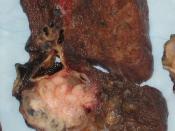Cancer is a genetic disease requiring a series of change. Carcinogenesis is the development of cancer.
Cancer cells are abnormal cells and they have characteristics that can be associated with their ability to grow uncontrollably. Cancer cells are non-specialized, and divide uncontrollably. Cancer in situ is a tumor located in its place of origin. Malignant tumors establish new tumor distant from the primary tumors.
Cancer cells characteristics distinguish them from normal cells. They have abnormal nuclei with many chromosomal irregularities. They form tumors because they do not exhibit contact inhibition. They induce angiogenesis and cause nearby blood vessels to form a capillary network that services the tumor.
Normal cells can undergo the cell cycle for about 50 times and then they die. Cancer cells can enter the cell cycle repeatedly, and in this way, they are potentially immortal. They are everlasting. Ordinarily, cells with damaged DNA undergo apoptosis, a series of enzymatic reaction that lead to the death of the cell.
Cancer cells fail to undergo apaptosis. With cancer cells this continues. Normal cells anchor themselves to a substratum and adhere to their neighbors. They exhibit contact inhibition and that is when they come in contact with a neighbor, they stop dividing. Cancer cells have lost all restraint and they pile on top of one another to grow in multiple layers and that's why they grow.
Normal cells do not grow and divide unless they are stimulated to do so by a growth factor. Cancer cells no longer respond to inhibitory growth factors such as transforming growth factors beta from their neighbors. Their growth, termed neoplasia, contains cells that are disorganized, a condition termed anaplasia.
Cancer cells metastasize because of the blood supply. The cancer cell must make their way across a basement membrane and into a blood vessel or lymphatic vessel. When cancer gets into your lymphatic it will take it to the rest of the body.
Cancer cells require a series of mutations. Each of the cells propel towards the development of a tumor, which is an accumulation of cancer cells that no longer function properly. The development of cancer is a gradual process, which may take years before a person show signs and symptoms of a tumor. Even though tumor cells may show commons characteristics, each type of cancer may have its own particular sequence of mutation. This results in the uncontrolled growth.
Normal cells don't grow and divide unless they are stimulated to do so by a growth factor. Cancer cells have a reduced need for growth factor. Such as epidermal growth factor in order to grow and divide. Conversely cancer cells no longer respond to inhibitory growth factors such as transforming growth beta (TGF-B) from their neighbors,





